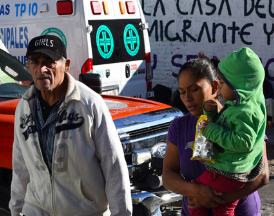The flood of asylum seekers at our southern border has put a point on the severity of the United States’ immigration problem. It’s also punctuated what a problem it is for Washington.
To truly stem the tide of illegal migration, lawmakers need solutions that turn off the spigot rather than just pinch the hose. That requires elevating economic conditions in Central American countries, particularly those like Honduras, Guatemala and El Salvador, where most migrants originate. Here, the United States’ newfound energy security provides a potential win-win solution.
Reliable energy is an anchor of economic growth and personal opportunity. Yet, many Central American countries lack basic infrastructure, which contribute to systemic power shortages. Honduras, for example, where rolling blackouts are common, is ranked 153 out of 190 countries by the World Bank for ease of getting electricity. The dismal status owes largely to crony politics that prevent meaningful development.
One can imagine how difficult it is to run a business under such uncertainty. Coupled with rampant corruption, it’s difficult for citizens to create opportunity for themselves. The chance at the American Dream then quickly becomes worth the risk, no matter how much officials beef up the barriers, when there is little hope at home.
For the first time in generations, the United States is positioned with both the energy resources and the know-how to affect change in Central America. Domestic shale development has equipped the United States with vast oil and gas reserves. America is projected to become a net-energy exporter by 2020, the first time since the 1950s. That’s been a boon for our economy, and it’s reached a point that producers need more demand to keep prices at a sustainable level.
More and more, U.S. producers are finding that demand beyond our borders. Crude oil exports achieved a record high in 2018, and liquefied natural gas exports are expected to double this year. After years of investment, export facilities are beginning to come online, which move U.S. energy products to countries in need. That’s good not only here at home but also abroad. The demand helps support baseline prices for producers — which ensures wells keep running and consumer prices stay low — and it provides much-needed resources to our allies.
Unlike taxpayer-funded aid, this kind of energy deployment can be achieved without committing U.S. tax dollars. American companies share a financial incentive to extend a hand to developing countries, and their involvement creates a natural trade alliance to bolster relations. That’s an outcome that benefits all involved and can help mitigate the bureaucracy and delays that accompany most government deals.
What’s more, pipeline projects being developed by the private sector offer a proven and reliable solution to Central America’s infrastructure woes. Pipelines are the most effective and safest form to move energy products. They invest in communities with good-paying jobs, economic opportunity and long-term revenue — the kinds of things that improve the quality of life.
Lawmakers have a reason to open the doors to public-private partnerships that will help provide energy to Central American countries. While Washington has been busy haggling over border policy, competitors like China and Russia have been stepping into the markets in our backyard with a strong presence.
In recent years, China has provided $139 billion in loans to Venezuela (where the turmoil caused by a collapsing energy grid is evident), Brazil, Argentina and Ecuador. More and more, energy development in Central America is being financed by the Chinese, which is fast establishing the Red Dragon as the de facto commercial bank in the region. That’s a powerful stronghold that lends a lot of political influence.
Public-private partnerships to deploy infrastructure and energy to Central America are already starting to alleviate some of the distress in those nations. Lawmakers would be wise to put their support into driving these solutions forward. Certainly, there’s a lot of work to do to strengthen our borders. But without a fix that addresses the problem at its source, immigration policies will continue to fight the symptoms and not the sickness.

